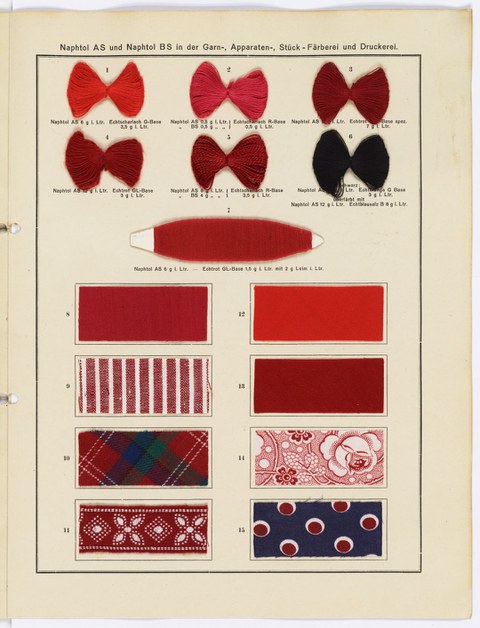Dye Collection

Staining pattern of Naphtol Dye, Chemische Fabrik Griesheim-Elektron 1921
The Dye Collection is one of the most important scientific collections at the TU Dresden. It houses more than 1,500 natural dyes from plant and animal sources, over 20,000 trade patterns of synthetic dyes from more than 80 industrial producers, classified by their chemical structure, as well as over 2,000 colour sample charts and numerous staining patterns. The oldest colour samples in the collection date back to ca. 1830, whereas some other historical colour samples stem from the London World’s Fair in 1851. The original sample of aniline purple is also in the collection, as is the first usable tar dye, which was produced by W. Perkin in 1856. The institute’s scientific activities can be traced through student theses, which have been collected since 1890, along with the preparations manufactured for them. Since 1928, the Dye Collection has been situated in the König Building, named for the institute’s most famous professor. The collection is preserved in the historic collection rooms next to the chemical dyes laboratory and the historical auditorium.
More information about the Dye Collection
Anlässlich der Verleihung des Titels Historische Stätte der Chemie gab die Kustodie diesen Dronenflug durch den König-Bau und die Historische Farbstoffsammlung in Auftrag. © Kustodie / Theis Meckbach
On October 12, 2023, the König Building was honored as a "Historic Site of Chemistry" during a festive ceremony. Since 1999, the German Chemical Society has used this title to honor achievements of historical significance in chemistry.
Literature
H. Hartmann, K. Vincenz, Die Farbstoffsammlung, in: Sammlungen und Kunstbesitz, Technische Universität Dresden. Hrsg. von der Rektorin der Technischen Universität Dresden. Dresden 2022, p. 57-68.
A. Losse, B. Werner, Die Dresdner Farbstoffsammlung, in: Chemie in unserer Zeit 27, 1993, p. 237-238.
Contact
TU Dresden, Faculty of Chemistry and Food Chemistry
König-Bau
Bergstr. 66c, 01069 Dresden

